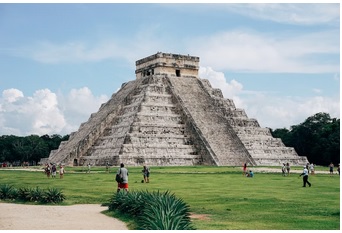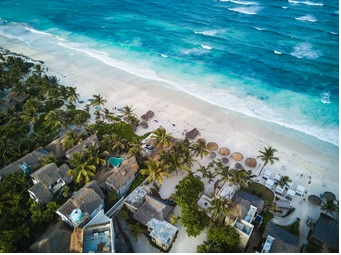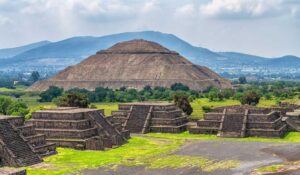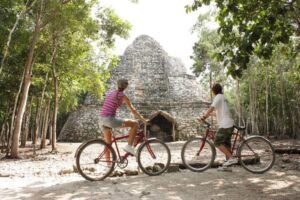Mexico, a country with a diverse history, culture, and geography, enchants visitors worldwide. Amidst the vast cities, golden coastlines, and various terrains, Mexico’s ancient relics tell tales of once-flourishing civilisations. Delving into the remnants of the Mayan and Aztec realms reveals distinct characteristics and enigmas from eras, offering a profound insight into Mexico’s rich heritage and essence.
Mayan Marvel: Chichen Itza
 Of all the numerous Mayan ruins, Chichen Itza, a UNESCO World Heritage Site, is undoubtedly the most spectacular. The Temple of Kukulcan, El Castillo, is the centre of gravity for this ancient metropolis. With its 365 steps representing the solar year, this pyramid showcases the Mayans’ impressive knowledge of astronomy and mathematics.
Of all the numerous Mayan ruins, Chichen Itza, a UNESCO World Heritage Site, is undoubtedly the most spectacular. The Temple of Kukulcan, El Castillo, is the centre of gravity for this ancient metropolis. With its 365 steps representing the solar year, this pyramid showcases the Mayans’ impressive knowledge of astronomy and mathematics.
Equally fascinating are the Great Ball Court, Temple of the Warriors, and the Sacred Cenote, each a testament to the advanced civilisation that built them. If you’re planning a trip, remember to read more about obtaining an e-visa to ensure a smooth journey to those ancient wonders.
Palenque: A Jungle Enigma
 Hidden in the tropical jungles of Chiapas, Palenque is another enchanting Mayan site. The Temple of Inscriptions, housing the tomb of the ancient ruler Pakal the Great, is the crown jewel of this archaeological site. The carved hieroglyphics on the grave tell tales of the ruler and his reign.
Hidden in the tropical jungles of Chiapas, Palenque is another enchanting Mayan site. The Temple of Inscriptions, housing the tomb of the ancient ruler Pakal the Great, is the crown jewel of this archaeological site. The carved hieroglyphics on the grave tell tales of the ruler and his reign.
Tulum: Mayan Ruins by the Sea
 The ruins of Tulum lie on the Riviera Maya, overlooking the azure waters of the Caribbean Sea. Known for its picturesque setting, Tulum was once a bustling seaport. The well-preserved El Castillo and the Temple of the Frescoes offer captivating insights into Mayan art and architecture.
The ruins of Tulum lie on the Riviera Maya, overlooking the azure waters of the Caribbean Sea. Known for its picturesque setting, Tulum was once a bustling seaport. The well-preserved El Castillo and the Temple of the Frescoes offer captivating insights into Mayan art and architecture.
Aztec Splendor: The Templo Mayor
 The Templo Mayor, a prominent Aztec archaeological site, is located in the centre of Mexico City amidst all the noise and activity. It served as the primary temple for the gods of war and agriculture in the ancient Aztec city-state of Tenochtitlan. Today’s site provides a rare look into the splendour of the Aztec culture despite being substantially devastated after the Spanish conquest.
The Templo Mayor, a prominent Aztec archaeological site, is located in the centre of Mexico City amidst all the noise and activity. It served as the primary temple for the gods of war and agriculture in the ancient Aztec city-state of Tenochtitlan. Today’s site provides a rare look into the splendour of the Aztec culture despite being substantially devastated after the Spanish conquest.
Teotihuacan: The City of Gods
 Close to Mexico City lies Teotihuacan, often hailed as “the birthplace of the gods.” Before the Spanish invasion, this vast metropolis stood as a testament to the zenith of ancient pre-Aztec societies, reigning as the largest in the Americas. The Temple of Quetzalcoatl and the renowned Sun and Moon Pyramids are among its architectural marvels.
Close to Mexico City lies Teotihuacan, often hailed as “the birthplace of the gods.” Before the Spanish invasion, this vast metropolis stood as a testament to the zenith of ancient pre-Aztec societies, reigning as the largest in the Americas. The Temple of Quetzalcoatl and the renowned Sun and Moon Pyramids are among its architectural marvels.
Monte Alban: A Panoramic Historic Site
Perched on a hilltop with stunning panoramic views, Monte Alban was the ancient capital of the Zapotec civilisation. This UNESCO World Heritage site, with its Grand Plaza, Ball Court, and Tomb 7, rich with gold and silver artefacts, highlights its creators’ architectural genius and sophisticated society.
Uxmal: The Three Times Built City
In the Yucatan Peninsula, nestled amid dense forest, is the serene and majestic Uxmal, a significant Mayan city. Its name translates to ‘thrice-built,’ reflecting the ancient belief that the town was built, destroyed, and rebuilt twice. The Pyramid of the Magician, with its unique elliptical base, dominates the landscape of Uxmal. It provides sweeping views of the surrounding ruins, especially the Nunnery Quadrangle and the Governor’s Palace, as it is the tallest building in the city. Known for their elaborate geometrical and symbolic decorations, these well-preserved buildings are remarkable examples of Puuc architectural style, exhibiting the Mayans’ artistic and technical prowess.
Coba: An Ancient Mayan Highway
 Hidden within the dense jungle of Quintana Roo, Coba offers a unique and adventurous experience. Compared to most Mayan cities, Coba isn’t centralised around a single plaza. Instead, Sacbeob – ancient white roads- dispersed and connected the city’s structures. The tallest pyramid in the Yucatan Peninsula, the Nohoch Mul, is the highlight of this archaeological site. Climbing its 120 steep steps rewards visitors with an unmatched view of the lush jungle canopy. The ball courts, stelae, and other remnants whisper tales of this once-flourishing city. The city’s strategic location and extensive road network suggest that Coba was a crucial centre for trade and political power in the ancient Mayan world.
Hidden within the dense jungle of Quintana Roo, Coba offers a unique and adventurous experience. Compared to most Mayan cities, Coba isn’t centralised around a single plaza. Instead, Sacbeob – ancient white roads- dispersed and connected the city’s structures. The tallest pyramid in the Yucatan Peninsula, the Nohoch Mul, is the highlight of this archaeological site. Climbing its 120 steep steps rewards visitors with an unmatched view of the lush jungle canopy. The ball courts, stelae, and other remnants whisper tales of this once-flourishing city. The city’s strategic location and extensive road network suggest that Coba was a crucial centre for trade and political power in the ancient Mayan world.
Exploring the ancient ruins of Mexico is like stepping into a time machine. The impressive structures of Chichen Itza, the jungle enigma of Palenque, the seaside ruins of Tulum, the heart of the Aztec empire at Templo Mayor, and the city of gods at Teotihuacan, each narrate stories of the past that shaped Mexico. These ancient relics are not just stones and structures but the country’s cultural legacy, beckoning travellers to journey through time and discover this enchanting land’s rich history and mysteries.




